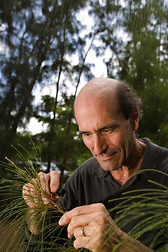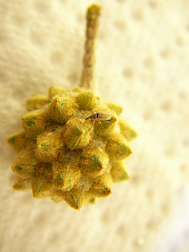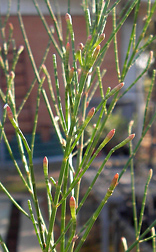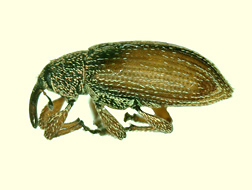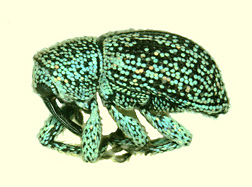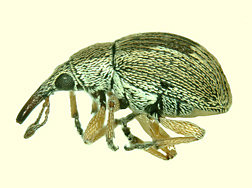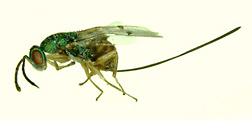In Search of Biological Control
Agents for the Invasive Australian Pine
The Australian outback is known for its wild and wide-open spaces, clean air, and breathtakingly clear night skies. Many venture to these remote parts of the continent for the tranquillity the outback offers.
But for Agricultural Research Service entomologist Greg Wheeler and his ARS and university colleagues, touring the outback—along with expeditions to the pristine Australian coastlines—was much more than mere adventure. Their trips Down Under were to search for biological control agents for highly invasive Casuarina species, commonly called “ironwood,” “horsetail tree,” or “Australian pine.”
Not really a pine tree, this extremely problematic weed is infiltrating U.S. coastal areas, especially in south Florida, the Virgin Islands, Puerto Rico, and Hawaii. In Florida it’s a problem in the Everglades National Park and surrounding areas. Known for its rapid growth, dense coverage, and thick litter accumulation, Australian pine inhibits growth of native plants. It is also very salt tolerant, which allows it to grow on coastal dunes, increasing beach erosion and interfering with nesting by endangered crocodiles and sea turtles. Australian pine was brought into the United States in the early 1900s as an ornamental shade tree.
|
|
But something went terribly wrong.
“While there are some fine qualities to Casuarina,” says Wheeler, who’s in ARS’s Invasive Plant Research Laboratory (IPRL) in Fort Lauderdale, Florida, “its negatives far outweigh its positives.”
The Australian pine problem includes three Casuarina species: C. equisetifolia, C. glauca, and C. cunninghamiana.
In the past few years, the Australian members of the team—Matthew Purcell, director of ARS’s Australian Biological Control Laboratory (ABCL) in Indooroopilly, Queensland, ABCL researcher Bradley Brown, and Gary Taylor from the University of Adelaide, Australia—conducted five separate trips throughout Australia. They were joined in a May 2007 expedition by IPRL research leader Ted Center. In all, the expeditions covered more than 5,000 miles in northern and eastern Australia, encompassing much of the Northern Territory and the states of Queensland, New South Wales, and Western Australia.
|
|
Purcell, Brown, Taylor, and John Gaskin, research leader of ARS’s Pest Management Research Unit in Sidney, Montana, comprise a Casuarina research team.Wheeler served as the lead scientist for the project, coordinating the funding, surveys, and plant DNA testing. (See sidebar, facing page.)
From a bounty of some 300 wasps, weevils, stem borers, sap suckers, seed eaters, and others, the scientists have narrowed the field of potential control agents to about 12 candidates that attack not just C. equisetifolia, but also C. glauca and C. cunninghamiana. One of the main thrusts behind the survey work has been to find seed, flower, or fruit feeders to halt reproduction without destroying parent trees.
“Many Floridians enjoy the shade provided by these trees,” says Center, “but don’t like it when Casuarinas invade our natural areas.”
Among the top finds were the seed eater Bootanelleus orientalis, which is host specific to Australian pine, and a defoliator moth, Zauclophora pelodes. Many others are yet to be classified, and some were previously unknown to science. Most of the identifications were conducted by taxonomists at various participating institutions, with the Commonwealth Scientific and Industrial Research Organization’s Australian National Insect Collection in Canberra leading the way.
|
|
These insects are still being tested by Purcell and colleagues in Australia to determine their suitability for biological control here in the United States.
“We’re pleased with the results so far and hope for more good news once further classification is completed,” says Wheeler.
With a keen interest in the results of the expeditions, the South Florida Water Management District, the Florida Department of Environmental Protection, and the National Park Service have all helped in funding this research.—By Alfredo Flores, Agricultural Research Service Information Staff.
This research is part of Crop Protection and Quarantine, an ARS national program (#304) described on the World Wide Web at www.nps.ars.usda.gov.
Ted Center and Gregory S. Wheeler are in the USDA-ARS Invasive Plant Research Laboratory, 3225 College Ave., Ft. Lauderdale, FL 33314; phone (954) 475-6543 [Center], (954) 475-6546 [Wheeler], fax (954) 476-9169.
John Gaskin is in the USDA-ARS Pest Management Research Unit, 1500 N. Central Ave., Sidney MT 59270; phone (406) 433-9444, fax (406) 433-5038.
Matthew Purcell and Bradley Brown are with the USDA-ARS Australian Biological Control Laboratory, 120 Meiers Rd., Indooroopilly, Queensland, Australia 4068; phone 011-61-732142847, fax 011-61-732142815.
|
|
Sorting Out Who’s Who Among Confusing Casuarinas
The saga of finding helpful Australian insects to stave off the spread of unwanted, pinelike Casuarina trees in Florida comes complete with its own mystery: It is often difficult to tell the various Casuarina species and subspecies apart.
Hidden amidst this confusion is a particularly taxing Casuarina—one long suspected of being a hybrid. It has no name, and no one knows, for certain, who its parents are.
|
|
The uncertainty about who’s who among the Sunshine State’s lookalike Casuarinas poses a problem to ARS scientists who may someday need to match Casuarina-quelling insects from Australia—the tree’s homeland—to invader Casuarina trees in Florida. The trick is to put the insects on the exact Casuarina species that they evolved with in Australia. Perfect matches may be critical to the critters’ success in stopping the uncontrolled advance of the weedy tree.
For botanist and research leader John Gaskin at Sidney, Montana, the Casuarina conundrum is like others he has encountered—and resolved. He’s already tackled the tangled lineages of tamarisk—another notorious intruder—and is currently making his way though the genetic jungle of hawkweeds of the Pacific Northwest, for example.
|
|
To solve the Casuarina puzzle, he’s using samples of DNA of Casuarinas from Australia—where their identification is certain. He’s comparing that DNA to DNA from the Casuarinas currently running amok in south Florida.
Technicians Kim Mann and Jeannie Lassey—with Gaskin’s research unit—extract DNA from pine-needle-like leaves that Gaskin collected in 2006 from Casuarinas growing along Australia’s eastern coast, as well as from specimens that colleagues Matt Purcell, Gary Taylor, and Greg Wheeler gathered elsewhere in Australia and in Florida.
The study is the first to use DNA to definitively identify the Florida Casuarinas. Making the correct identification is “a problem that can’t be solved by merely looking at the shape of the trees’ leaves or conelike flowers,” says Gaskin.
|
|
He expects to have final results sometime this year.—By Marcia Wood, Agricultural Research Service Information Staff.
"In Search of Biological Control Agents for the Invasive Australian Pine" was published in the September 2008 issue of Agricultural Research magazine.








